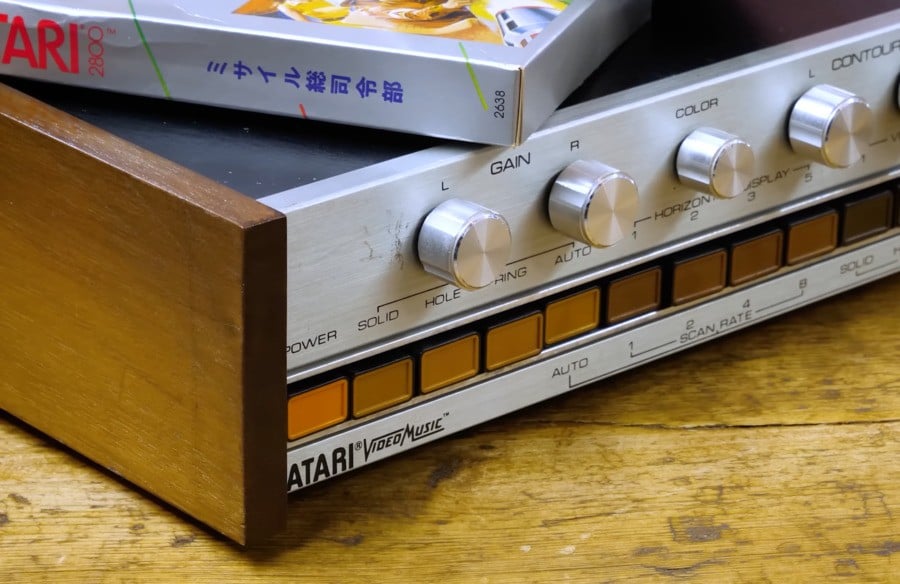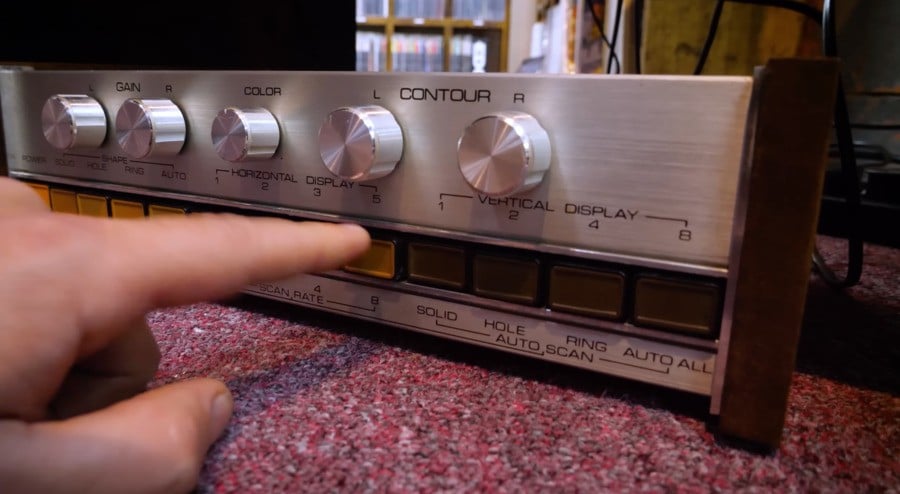
The chances are that you might never have heard of the Atari Video Music. Released in 1977, not long before the all-conquering Atari VCS, it was a device that somewhat resembled a hi-fi component, with a shiny oblong metal body sandwiched between two wooden panels.
The idea was that you would pump music into it via your stereo, and then it would output pulsing shapes on your TV screen that moved in time to the music. An array of buttons and dials on the front would then let you tune these visuals to your heart’s content, adjusting things like the number of diamond shapes and the extent to which they pulsed. It's a fascinatingly odd piece of kit.
I featured the Atari Video Music in my book, Curious Video Game Machines, in a chapter on Atari’s ‘forgotten’ consoles: devices that were launched before the debut of the Atari VCS and which are now little remembered. These devices included the unique-looking Stunt Cycle home console, which features motorcycle handlebars on the top, along with Video Pinball, which provided some surprisingly advanced ball movement for 1977.

But it’s the Atari Video Music that’s by far the strangest of these machines, and it’s almost certainly the first example of what we would now call a ‘light synthesizer’: music-responsive programs that would later be built into consoles like the Xbox 360. So, when I had a chance to speak with Atari founder Nolan Bushnell recently, I couldn’t resist asking him about this oddball piece of hardware.
When I catch up with Bushnell over Zoom, he’s sat in his workshop, surrounded by boxes of spare parts and rolls of tape. Now in his eighties, he’s still fond of messing around with electronics. “I was a full-on geek probably from the age of eight,” he tells me, saying that he began by tinkering around with ham radios. “If you were a full geek, you were a ham in those days, because computers weren't available,” he says. TVs were another early passion, he adds, saying that he ran a TV repair business when he was ten. It’s a reminder that Bushnell has always been an engineer, first and foremost.
But Bushnell wasn’t the engineer behind Video Music: that was Bob Brown, who had joined Atari’s Consumer Division from Standard Microsystems, while the project lead was Harold Lee, who had worked on the custom chip for Atari’s Home Pong console in 1975. The Video Music was originally known as MOOD, and according to the book Atari Inc.: Business is Fun by Marty Goldberg and Curt Vendel, it originated from conversations between Harold and Bob about how they could produce an ‘Audio-Video Color Kaleidoscope for Home Television’.

The resulting machine was certainly unique, but it was far from a best seller for Atari. “It was financially a major disaster,” says Bushnell when I ask him about the Video Music. “We planned our first production run of 2,000, [and] I think we sold ten at full price.”
The music visualiser was certainly an expensive proposition for consumers at its original retail price of £199.95. That’s the equivalent of more than $1,000 today and $10 more than the cost of an Atari VCS on its launch in September 1977. Previous Atari consoles had been sold by the major US department store chain Sears, and indeed, the first version of Atari’s Home Pong was branded as Sears Tele-Games Pong, but according to Goldberg and Vendel’s book, Sears initially refused to stock the Video Music.
That tallies with Bushnell’s memory of events: “If it had been in Sears, we'd have sold more than five,” he says. However, it does seem that Sears sold the Video Music at some point at a discounted price of $169.95, as there’s a listing for it in an old Sears catalogue.

In addition to the high price, Bushnell says that another reason for the machine’s failure was that it simply wasn’t practical for people to set up. “In analysis after, we found that people didn't have their TV and their stereo in the same room, unless you were in a small apartment,” he says. And as for how such a trippy machine ever got made, Bushnell has a simple explanation: “We realised that most of my engineers that were working on it were stoned all the time,” he says. “So they really loved it.”
But even though the Video Music bombed at retail, it did find its uses. Bushnell says that “almost every cable TV system had one”, and on channels playing nothing but music, the visuals would often be generated by Atari’s machine. The Video Music was also used to create the background visuals for the video to ‘The Day My Baby Gave Me A Surprise’ by the surrealist new wave band Devo, most famous for their 1980 single ‘Whip It’.
And importantly, the idea of generating visuals from music lived on, and was revisited independently by other people down the line. In 1984, Jeff Minter created the light synthesizer Psychedelia for the Commodore 64, and he followed this up with many more similar programs in the years that followed, including Colourspace (1985) and Trip-a-Tron (1987), as well as music visualisers for the Atari Jaguar, Nuon and Xbox 360. Interestingly, in an interview included in Llamasoft: The Jeff Minter Story, Minter says that he wasn’t aware of the Atari Video Music when he started making these light synthesizers, only coming across the machine much later.
PaRappa the Rapper creator Masaya Matsuura revealed in a recent episode of the podcast My Perfect Console that he also had ideas along the same lines in the 1980s. He had a program for the Apple II called Kaleidoscope that generated abstract images, and he said he wanted to synchronise the kaleidoscopic graphics with his own music, but wasn’t able to at the time.
Later, in the 1990s, music visualisation programs became widespread, which just goes to show that the Atari Video Music was far ahead of its time. The idea was sound, but the expense of the hardware and the difficulty in setting it up was enough to kill the machine before it could catch on.
Nowadays, the Video Music is something of a collector’s item. At one point Atari struggled to even give them away, but now they fetch around $500 on the rare occasions when they come up for sale on eBay, with the scarcity of the machine helping to drive up the price.
I’m curious: does Bushnell still have one? “I’ve got two in my garage,” he smiles. “But I don’t have a TV they’ll work on.” Ah, the familiar old problem of setting up 1970s technology. It’s a shame he didn’t keep a set from his childhood TV repair days.
